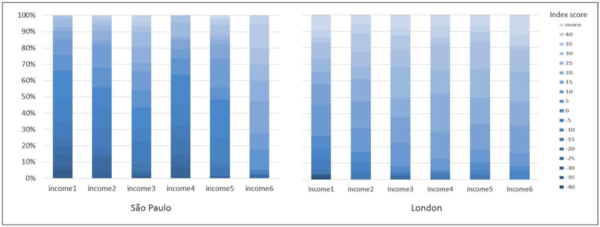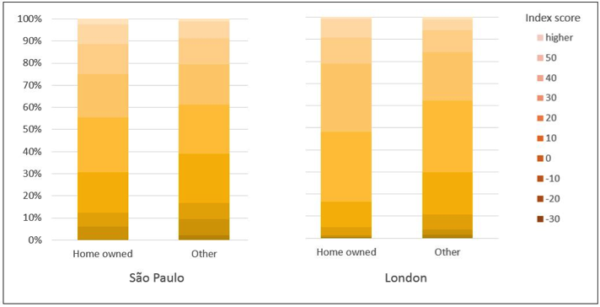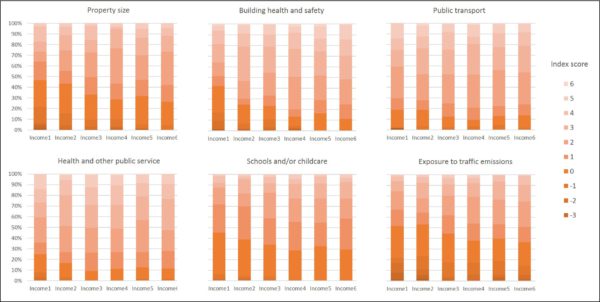Disparities in housing quality and affordability between social groups — A study within the ASTRID project
Like Jiang and Alex Hagen-Zanker
The ASTRID (Accessibility, Social justice and TRansport emission Impacts of transit-oriented Development strategies) project seeks to investigate the causal mechanisms underlying disparity and social injustice in job accessibility and air quality in metropolitan areas, and the potential of transit-oriented development to promote social justice. The project is a joint collaboration between the University of São Paulo, the University of Twente and the University of Surrey, within the scope of the FAPESP-ESRC-NWO Joint Call for Transnational Collaborative Research Projects.
The project consists of three main work packages: 1. Emission-exposure and social justice; 2. Land use, housing and social justice; and 3. Transit-oriented development, accessibility and social justice. Three study areas are considered in this project: São Paulo, Brazil; London, UK; and Randstad, Netherlands.
The housing quality and affordability surveys

Within the ASTRID project, we have conducted a large social survey of housing, jobs and air quality in each of the case study cities. One purpose of the survey is to evaluate housing quality and affordability in the three areas, and compare them between social groups and locations.
Housing plays a fundamental role in determining the well-being of households, and research has shown disparities in housing quality and affordability between different social groups and regions. However, it has also been argued that housing quality is context-dependent and it is difficult to envisage objective standards to measure housing quality across diverse households and regions. Similarly, objective housing affordability indices such as ratio measures and residual measures, predominantly used in policy making, may not reflect the real difficulties families may experience in obtaining adequate housing, considering their specific situations and needs.
So in our surveys, we asked participants to rate the quality and affordability of their housing themselves, and from their own perspectives. Fourteen aspects of housing were considered, including property size, building health and safety, eviction risk, proximity to work, employment opportunities, public transport connections, access to health and other public services, the availability of (good) schools, grocery shops and other amenities, outdoor recreation opportunities, indoor recreation opportunities, proximity to friends and family, the intimacy and safety of the neighbourhood, and exposure to traffic emissions. The relative importance of these different aspects according to each participant was also ranked. The data collected in our surveys will enable comparisons of self-assessed housing quality and affordability on multiple aspects between social groups and regions, which is rare in the current literature. It will provide useful evidence on people’s satisfaction with housing and prospects of improvements, and how they differ between social groups and regions.
In total, 1,559, 1,400 and 1,785 complete responses have been obtained in surveys in São Paulo, London and Randstad respectively. The recruitment of participants was controlled to ensure that the samples are representative for different social groups.
Preliminary results and on-going work
Preliminary analysis of the data from the London and São Paulo housing surveys shows that self-assessed housing quality and/or possibility to improve generally increase by income in both cities, with larger percentages of participants giving higher ratings in higher income groups (Figure 2). The pattern is clearer in London and ratings are relatively higher in London. Comparing home-ownership groups, in both London and São Paulo, home owners are more likely to give higher ratings (Figure 3).


For individual housing attributes, results of the London survey (Figure 4) show that people with higher incomes are more likely to be satisfied with current property size, building health and safety, access to school and/or childcare, and traffic emission level, and/or be able to afford to improve them. There is less difference in ratings on public transport connection and access to health and other public services between income groups.

Nearly half of the participants in London expressed that they would not be able to move home (Figure 5), and about 70% of them are prohibited by the effort and/or cost of moving. People with home ownership and/or higher income are more likely to be able to move.

Further analysis will be made for all the three study areas. Although our main interest is in disparities between income groups, home ownership, household type, ethnicity, education and other variables will also be considered in the comparison.
Final conference of the ASTRID project
The results of this housing quality and affordability study, along with other project outcomes, will be presented at the final project conference, which will be held in São Paulo at the end of August 2018. There will be a one-day workshop at the University of São Paulo and a half-day presentation on the policy implications at the City Hall. The details will be available on our website (https://www.astridproject.com/) shortly.
 The ASTRID project
The ASTRID project